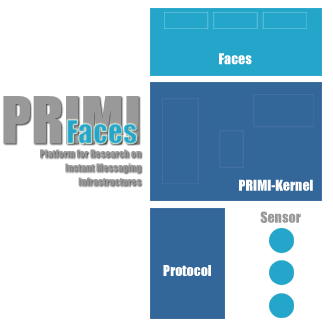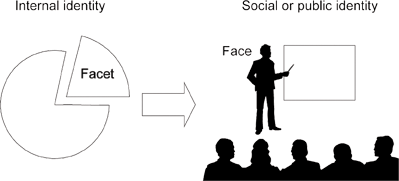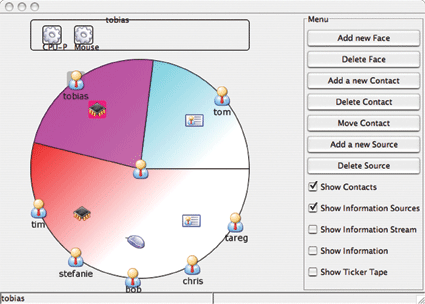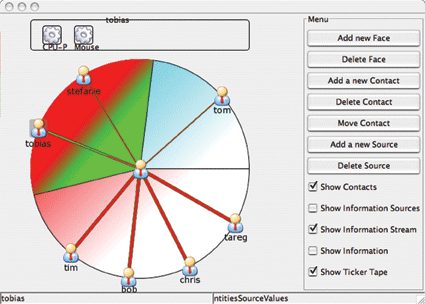|
|
RP_PRIMI_IIIPRIMIFaces - Summer Term 2005DescriptionPRIMIFaces is the third project of the PRIMI series that addresses the selective disclosure of personal and context-related information in a client-side approach (cf. Figure 1). Information is either gathered by sensors or provided explicitly by the users. The PRIMIFaces prototype provides users with means to control incoming and outgoing information in an integrated user interface. It is used for studying people’s habits and behaviours when spreading and receiving information in the digital realm. Figure 1. An overview of PRIMIFaces client components based on the PRIMI platform. The figure shows the PRIMI Kernel and further key components realised as plugins (protocols, user interfaces and sensors). In the real world we usually control implicitly what information to expose about ourselves. According to Goffman (1959) we construct social identities or faces representing a subset of sometimes intimate details to reveal to a certain audience—that is, we selectively disseminate information depending on the current temporal, spatial, and interpersonal context (cf. Figure 2).  Figure 2. According to Goffman (1959) everyone has a single internal identity from which we present only a fragment (a facet) to a particular audience as our social or public identity in that context (a face). PRIMIFaces is grounded on Goffman’s notion of faces. Every user has at least a default or public face besides an arbitrary number of custom faces (e.g., work, projects, friends). For each face users can assign specific information sources—information they choose to reveal via the respective face. Sources can be sensors (e.g., application sensors capturing information from the users’ applications) or free-form static information explicitly provided by the users (e.g., the phone number or email address). Additionally, users may assign other users to particular faces as contacts who receive the face’s information (cf. Figure 3). In turn the contacts can provide their information on a face basis. The assignment of faces and their respective sources and contacts can be symmetrical or asymmetrical. For instance, concerning sources user A can share more information with user B than user B offers in turn. In any situation users can open and close faces according to their personal preferences.  Figure 3. The PRIMIFaces user interface. The center represents the logged in user. There are currently three faces: two with one user and one source each (upper portion of the circle), and a third one with five users and three sources assigned (lower portion of the circle). PRIMIFaces additionally provides visualisations that give the users impressions on the relationship of incoming and outgoing information. The relationship is shown on an individual contact, individual face, or overall user level (cf. Figure 4).  Figure 4. Visualising the realtions of incoming and outgoing information: The upper left face shows one face and two user gradients. The green colour represents incoming information while red depicts outgoing information. The number of sources involved is indicated by the gradient’s thickness. In the upper left face the logged in user (center) provides one source to two users (Stefanie and Tobias). However, the user Tobias provides two sources accounting for one-third of the gradient to be green. Stefanie currently offers no information leading to an entirely red gradiant (only one outgoing source). The face’s gradient indicates half incoming and half outgoing information (two incoming from Tobias and one outgoing for each user). PRIMIFaces is based on the PRIMIBase 3.0 and SensBase infrastructures that have been implemented with the CML platforms PRIMI and Sens-ation (cf. Figure 5). Sensors are implemented as plugins. Their instances are adaptable in sampling and precision—that is, in how often they gather values with what level of detail. Sensors can be turned on and off (‘muted’). PRIMI’s logging mechanisms were rearranged and extended in order to support the dynamic integration of sensors at run-time. Sensor values and the relations of sensors, faces, and contacts are stored within the SensBase infrastructure. XML-RPC is used for the communication of this data. Additionally, the user interface provides simple chat functionality using the eXtensible Message and Presence Protocol (XMPP).  Figure 5. PRIMIFaces leverages new features of the PRIMI platform implemented in our PRIMIBase infrastructure version 3.0. Its logging hierarchy was rearranged to selectively control multiple sensors added as sensor plugins possibly at run-time. Logging is done via XML-RPC to the SensBase infrastructure. Current StatusFinished.Past Events
ResourcesPeopleTim GollubTobias Langlotz Mario Urbina Stefanie Zollmann Tom Gross (Supervisor) Christoph Oemig (Supervisor) Created by: oemig last modification: Friday 30 of June, 2006 [09:14:58 UTC] by alex |

